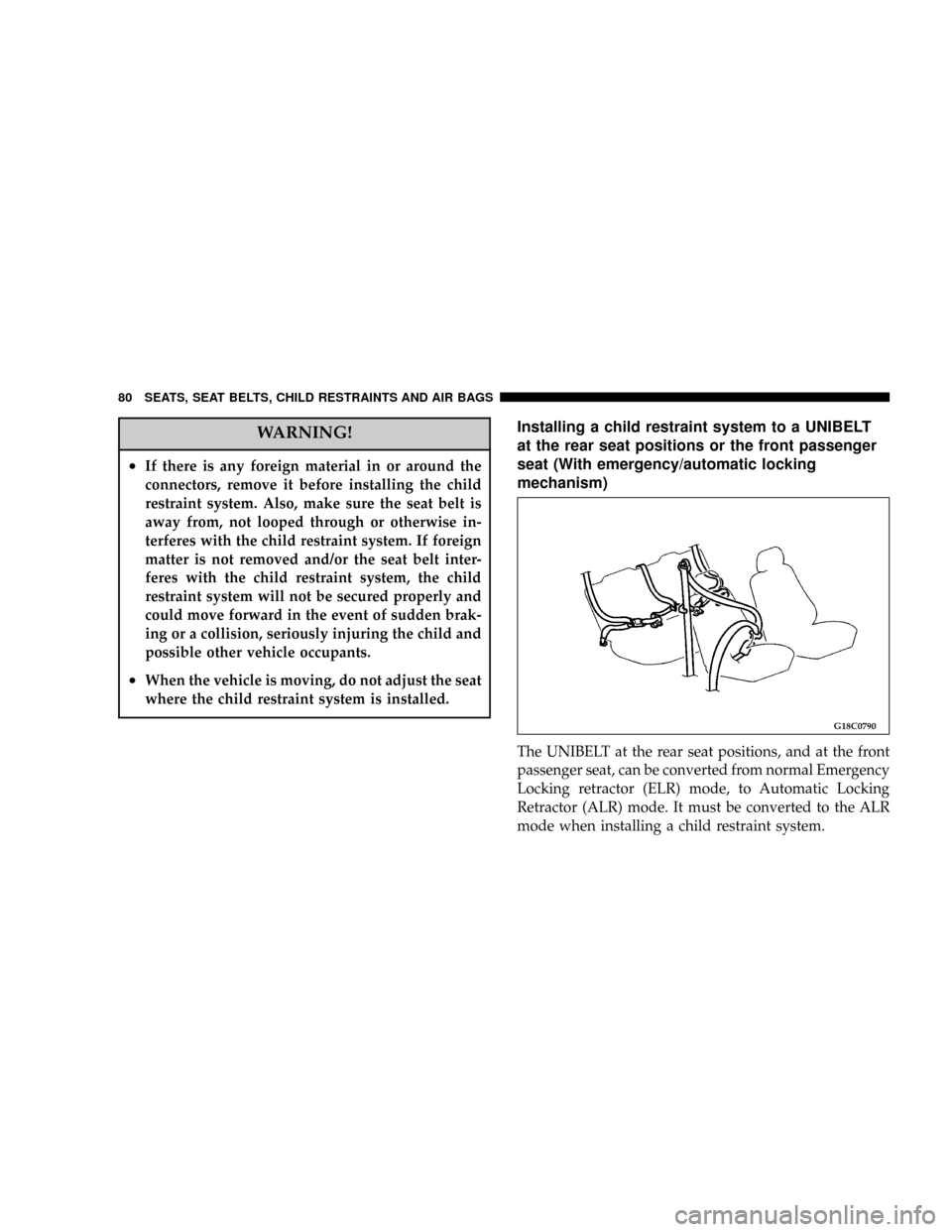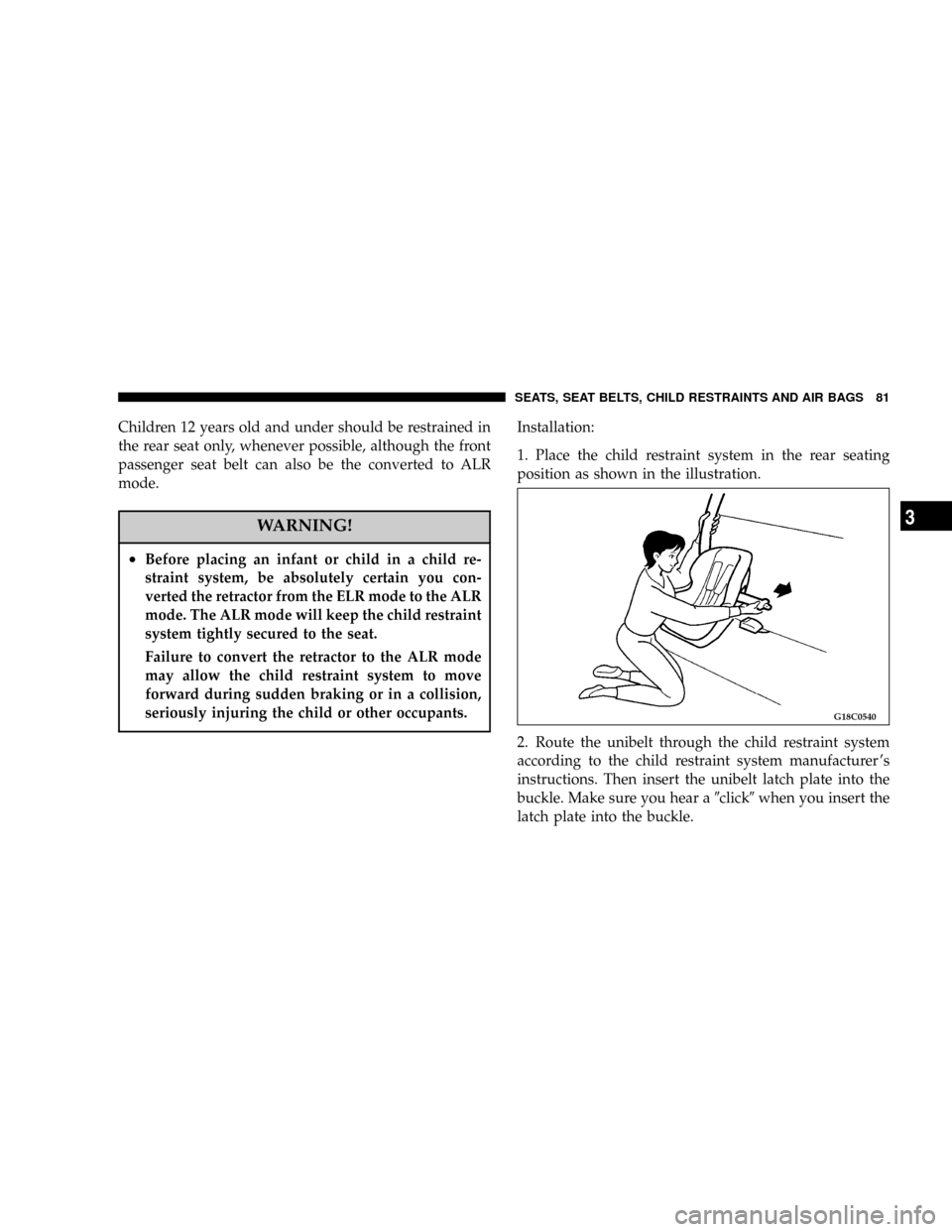Page 76 of 382
WARNING!
This vehicle is also equipped with a front passenger
air bag. Rear facing child restraints place an infant
too close to the air bag, the force of an inflating front
passenger air bag could strike a rear-facing child
restraint, causing serious or fatal injury to the child:
REAR-FACING CHILD RESTRAINTS MUST
ONLY BE USED IN THE REAR SEAT.
WARNING!
FRONT-FACING CHILD RESTRAINTS should al-
ways be used in the rear seat whenever possible; if
one must be used in the front passenger seat, adjust
the seat as far back as possible and ensure that the
child stays in the child seat properly restrained.
Failure to do so could kill or cause serious injury to
the child.
G28G3170
Air bag cover
G28G1060
76 SEATS, SEAT BELTS, CHILD RESTRAINTS AND AIR BAGS
Page 77 of 382

WARNING!
²It is important to use an approved rear facing
infant restraint until the infant is one year old to
allow the infant's neck and spine to develop
enough to support the weight of their head in the
event of a collision.
²When installing a child restraint system, follow
the instructions provided by the manufacturer
and follow the directions in this manual. Failure
to do so can result in severe or fatal injury to your
child in a collision or sudden stop.
²After installation, push and pull the child re-
straint system back and forth, and side to side, to
see that it is firmly secured. If the child restraint
system is not installed securely, it may cause
injury to the child or other occupants in the event
of a collision or sudden stop.
²When not in use, keep your child restraint system
secured with the seat belt or remove it from the
vehicle in order to prevent it from being thrown
inside the vehicle during an accident.
NOTE: Before purchasing a child restraint system, try
installing it in the rear seat to ensure a good fit. Due to the
location of the seat belt buckles and the shape of the seat
cushion it may be difficult to securely install some child
restraint systems.
If the child restraint system can be pulled forward or to
either side easily on the seat cushion after the seat belt
has been tightened, choose another child restraint sys-
tem.
²Depending on the seating position in the vehicle and
the child restraint system that you have, the child
restraint can be attached using one of the following 2
methods:
²To the lower anchorage in the rear seat ONLY if the
child restraint complies with Federal Motor Vehicle
Satety Standard 213 (See page 78).
²To the UNIBELT (See page 80).
SEATS, SEAT BELTS, CHILD RESTRAINTS AND AIR BAGS 77
3
Page 78 of 382
Installing a new child restraint system to the lower
anchorage
Your vehicle's rear seat is fitted with lower anchorages
for attaching a new child restraint system that complies
with Federal Motor Vehicle Safety Standard 213.
NOTE
²
The marks on the seatback show the location of the
lower anchorage points.
New child restraint system that complies with
Federal Motor Vehicle Safety Standard 213
A: Rear-facing child restraint
B: Forward-facing child restraint
C: Child restraint system connectors
(These are only examples.)
G08C0070G18C0750
78 SEATS, SEAT BELTS, CHILD RESTRAINTS AND AIR BAGS
Page 79 of 382
Installation
1. Open the gap a little between the seat cushion (A) and
the seatback (B) with your hand to locate the lower
anchorages (C).
2. Push the child restraint system's connectors into the
lower anchorages (C) in accordance with the instructions
provided by the child restraint system's manufacturer.3. If your child restraint system requires the use of a top
tether strap, refer to ``Tether anchors for child restraint
systems'' on page 83.
4. Push and pull the child restraint system in all direc-
tions to be sure it is firmly secured.
NOTE:
²For a new child restraint system that complies with
Federal Motor Vehicle Safety Standard 213, it is not
necessary to secure the child restraint system using the
vehicle's seat belt.
G18D0240
SEATS, SEAT BELTS, CHILD RESTRAINTS AND AIR BAGS 79
3
Page 80 of 382

WARNING!
²If there is any foreign material in or around the
connectors, remove it before installing the child
restraint system. Also, make sure the seat belt is
away from, not looped through or otherwise in-
terferes with the child restraint system. If foreign
matter is not removed and/or the seat belt inter-
feres with the child restraint system, the child
restraint system will not be secured properly and
could move forward in the event of sudden brak-
ing or a collision, seriously injuring the child and
possible other vehicle occupants.
²When the vehicle is moving, do not adjust the seat
where the child restraint system is installed.
Installing a child restraint system to a UNIBELT
at the rear seat positions or the front passenger
seat (With emergency/automatic locking
mechanism)
The UNIBELT at the rear seat positions, and at the front
passenger seat, can be converted from normal Emergency
Locking retractor (ELR) mode, to Automatic Locking
Retractor (ALR) mode. It must be converted to the ALR
mode when installing a child restraint system.
G18C0790
80 SEATS, SEAT BELTS, CHILD RESTRAINTS AND AIR BAGS
Page 81 of 382

Children 12 years old and under should be restrained in
the rear seat only, whenever possible, although the front
passenger seat belt can also be the converted to ALR
mode.
WARNING!
²Before placing an infant or child in a child re-
straint system, be absolutely certain you con-
verted the retractor from the ELR mode to the ALR
mode. The ALR mode will keep the child restraint
system tightly secured to the seat.
Failure to convert the retractor to the ALR mode
may allow the child restraint system to move
forward during sudden braking or in a collision,
seriously injuring the child or other occupants.
Installation:
1. Place the child restraint system in the rear seating
position as shown in the illustration.
2. Route the unibelt through the child restraint system
according to the child restraint system manufacturer 's
instructions. Then insert the unibelt latch plate into the
buckle. Make sure you hear a9click9when you insert the
latch plate into the buckle.
G18C0540
SEATS, SEAT BELTS, CHILD RESTRAINTS AND AIR BAGS 81
3
Page 82 of 382
3. To activate the ALR mode, slowly pull the shoulder
part of the belt all the way out until it stops, then let the
belt feed back into the retractor.
4. After the belt has retracted, tug on it. If the belt is
locked, you will not be able to pull it out. If you can pull
the belt out, it is not locked and not in the ALR mode. You
will need to repeat steps 3 and 4.5. After confirming that the belt is locked, grab the
shoulder part of the belt near the buckle and pull up to
remove any slack from the lap part of the belt. Remem-
ber, if the lap part of the belt is not tight, the child
restraint system will not be secure. It may help to put
weight on the child restraint system and/or push on its
seatback while pulling up on the belt (see illustration).
G18C0550G18C0560
82 SEATS, SEAT BELTS, CHILD RESTRAINTS AND AIR BAGS
Page 83 of 382
6. If your child restraint system requires the use of a top
tether strap, refer to ªAnchors for the child restraint
systemº on page 83.
7. Before putting the child in the restraint, push and pull
the restraint in all directions to be sure it is firmly secure.
Do this before each use. If the child restraint system is not
firmly secure, repeat steps 1 through 6.
8. To remove a child restraint system and deactivate the
ALR mode, remove the child from the restraint. Unlatch
the buckle, remove the belt from the restraint and let the
belt fully retract.Tether anchors for the child restraint system
In compliance with the Federal Motor Vehicle Safety
Standards, your vehicle has 3 attachment points on the
rear shelf, located behind the top of your rear seat. For
securing a child seat tether strap to each of the 3 rear
seating positions (2 outer and 1 center) in your vehicle.
G28B1090
SEATS, SEAT BELTS, CHILD RESTRAINTS AND AIR BAGS 83
3